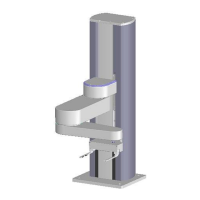3. Collaborative Robot Safety (Undefined variable: MyVariables.ProductName)
Robot Testing and Safety Circuits Part Number: PF40-DI-00010 Rev. A
Impact force against a rigid surface (trapping) is measured by moving the robot at speeds up to its
maximum permitted speed and payload with the compliance plate impacting the force sensor when
the force sensor is fixed to a rigid surface.
Pinch points. If a robot has pinch points, a full speed impact in these pinch points should not exceed
the quasi-static force above.
Pressure, or force per unit area, may be derived from the above tests and is not tested directly,
since it will depend on the application, including the end effector design. It is desirable to eliminate
sharp edges or points on the robot or end effector that can result in high pressures. In some case
foam padding or spring-loaded end effectors may be used to limit pressure during a collision.
Rounded covers and compliant covers (plastic) are helpful in limiting pressure during clamping or
impact collisions.
NOTE: PreciseFlex has tested and TUV has verified the forces for the PF400 robot
(See Appendix G: TUV Verification of PF400 Collision Forces). This data is intended
to aid the integrator in performing a Performance Level Assessment for determining
whether collision forces in a particular workcell may cause operator injury.
An example PLr workcell application assessment based on ISO 13849-1:2006 is given for a PF400
workcell in Appendix F: Example Performance Level Evaluation.
Controller Requirements
Early industrial robots were often large, powerful machines with payloads that could exceed 100 kg.
As a result, the industrial robot safety standards such as ISO 10218-1 often specified a Category 3
control system for these machines, see ISO 10218-1:2011 5.4.2 and 10218-2:2011 5.2.2. However,
these standards now recognize that not all robots are large, dangerous machines and include
clauses that allow less expensive controllers to be used if a risk assessment justifies this. 10218-
1:2011 5.4.3 states that “The results of a comprehensive risk assessment performed on the robot
and its intended application may determine that a safety-related control system performance other
than that in 5.4.2 is warranted for the application”. 10218-2:2011 5.2.3 makes a similar statement.
Note that in performing a risk assessment under ISO 13849, the first determination, S1 or S2, is
made based on whether an operator may sustain a serious or non-recoverable injury. For large,
heavy payload robots, S2 is typically selected and this immediately directs the evaluation result to a
PLr of c, d, or e, which indicate a Cat 3 controller. For low payload robots, S1 is typically selected
which directs the evaluation to a PLr of a, b, or c. In Appendix F: Example Performance Level
Evaluation, an example risk assessment is provided for a PF400 robot with a 500 gram payload and
the PL is determined to be “a.” This does not require a Cat 3 controller or robot system.
Possible PreciseFlex Controller Faults and Controller Testing
Notwithstanding the above, PreciseFlex controllers are designed so that no single failure can
disable the safety features in the controller and cause an uncontrolled motion. However, the 500 gm
payload PF400 robots are not Category 3 robots as they cannot cause serious injury and the
31
Copyright © 2023, Brooks Automation

